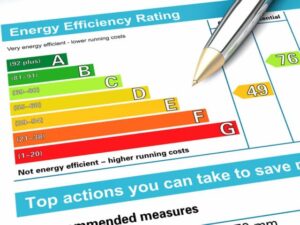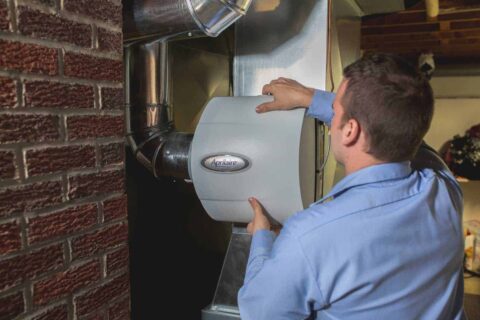SEER Ratings Explained: Essential Information for Homeowners
Key Takeaways
-
SEER ratings indicate how efficiently air conditioning units perform. A higher SEER rating means better energy performance.
-
Knowing how SEER ratings work and how to read them can help you find the most affordable and efficient air conditioners for your home.
-
You can save money by choosing an air conditioning unit with a higher SEER rating. Over time, you’ll save a lot on your energy bills.
-
Higher SEER ratings decrease energy usage and your energy bill, benefiting the environment.
-
To find out which SEER rating is best for you, consider your climate and budget. Consider the size of the room you want to cool.
-
Investing in a higher SEER-rated system may have a higher upfront cost. It can often result in lower energy costs and improved comfort in the long run.
SEER tells you how efficiently an AC unit uses energy. Higher ratings can result in less money spent on your bills and more comfort. Think of SEER as a report card for your AC’s efficiency. The higher the number, the better the performance and savings.
When you select an AC with a solid SEER rating, you’re also contributing to a healthier planet. Some governments reward eco-friendly decisions. Always check SEER ratings when buying a new system. This could save you money and save the planet.
SEER knowledge is power” is a requirement for smart decisions.
What Is SEER Rating
If you’re learning about air conditioner efficiency, your best friend is the SEER, or Seasonal Energy Efficiency Ratio. This efficiency rating measures how well an air conditioning system converts electricity to cooling over an average cooling season. Think of it like the miles-per-gallon (MPG) rating for cars — it helps you judge how efficient a unit runs. When you prioritize a good SEER rating, you are selecting an efficient air conditioner that uses less energy to cool your space.
Opting for a high SEER rating means you can expect substantial energy savings on your electric bill. Higher SEER air conditioners are designed to perform optimally, reducing overall energy consumption while maintaining indoor comfort. This is especially beneficial during the summer months when cooling needs increase significantly.
Choosing a new AC unit with a good SEER rating not only enhances your home’s comfort but also aligns with new energy standards aimed at minimizing electricity costs. By investing in an efficient system, you can enjoy a desirable indoor environment while contributing to energy bill savings and reducing your carbon footprint.
Definition of SEER
SEER measures the cooling output of an AC unit over a cooling season and is a crucial part of the HVAC efficiency measurement. It’s defined as the ratio of total cooling output divided by total electric energy input during that time. In simpler terms, a higher SEER rating indicates a more efficient air conditioning system, which is essential when evaluating the performance of different air conditioners.
Most homeowners find that a good SEER rating between 15 and 18 strikes a balance between upfront costs and long-term energy bill savings. By choosing high SEER ratings, such as those found in modern air conditioners with two-stage or variable-speed options, homeowners can significantly increase their overall energy consumption efficiency.
These high-efficiency systems not only provide optimal indoor comfort but also contribute to substantial energy savings over time. Therefore, when selecting a new HVAC system, it’s important to consider the SEER rating requirements to ensure maximum efficiency and effectiveness in meeting your cooling needs.
Importance of SEER in AC Systems
Higher SEER ratings in air conditioning systems make a significant difference in your energy usage and, consequently, your electric bill. Systems with a good SEER rating provide greater cost savings in the long run and help reduce your carbon footprint. Investing in a high SEER air conditioner can lead to substantial energy savings, especially during the summer months when cooling needs are at their peak.
For those seeking energy-efficient HVAC options, understanding SEER rating measures is essential. Since inefficient systems can waste up to 30% of energy use, knowing the minimum SEER ratings helps prevent that waste and ensures you select the right unit for your home. This knowledge can also guide you in choosing modern air conditioners that align with new energy standards.
In addition to SEER ratings, you’ll also want to consider upfront costs, maintenance, and the type of AC unit when making your decision. Each of these factors can influence the overall efficiency and effectiveness of your HVAC system, ultimately impacting your monthly energy bills and indoor comfort levels.
-
14 to 15: Affordable for budget-conscious buyers. 15 to 18: Balanced cost and energy savings. 18+: High efficiency, more savings long-term.
How SEER Ratings Work
Calculation Method
What is SEER, or Seasonal Energy Efficiency Ratio, and why does it matter? SEER is a crucial measure used to evaluate the efficiency of air conditioning systems, specifically the performance of seer air conditioners. It provides insight into how effectively an AC unit cools a space relative to the energy it consumes, making it an essential factor for homeowners looking to maintain indoor comfort.
To calculate SEER, divide the total cooling output of the AC unit by the total electric energy input during a typical cooling season. This formula ensures you’re seeing a realistic picture of how well an efficient air conditioner operates under standard conditions, helping you understand the energy usage patterns of different units.
Understanding SEER is important for consumers as it helps them make informed decisions when purchasing a new HVAC system. A higher SEER rating indicates better energy efficiency, which can lead to lower monthly energy bills and substantial energy savings over time, reducing the overall environmental impact.
These calculations also consider the different temperatures you can expect throughout the season, making them a reliable measure for comparing different air conditioning systems. When comparing units, you’ll want to look at the SEER rating, as it reveals which system offers the best efficiency for your cooling needs.
A unit rated at 16 SEER will provide twice the efficiency of one rated at 8, highlighting the importance of high SEER ratings in your decision-making process. This difference underscores the need to understand these ratings so you can make informed buying decisions that align with your financial goals.
In conclusion, recognizing the significance of the SEER rating scale is vital for selecting the right HVAC unit. By investing in a high efficiency air conditioner with a good SEER rating, you can enjoy a comfortable indoor environment while achieving energy bill savings and contributing to a more sustainable future.
Seasonal Energy Efficiency
Seasonal energy efficiency is about how well an air conditioning unit performs over an entire cooling season.
SEER ratings account for multiple outdoor temperatures and humidity levels. This makes them a comprehensive measure of an AC’s performance.
Once you grasp this, you can choose a system that works for you. It’ll also better enable you to use energy more wisely.
When you understand seasonal efficiency, you can make more informed decisions about which air conditioning system to purchase. A higher SEER rating means more energy efficiency, which could translate to savings on your energy bills.
For instance, an AC unit with a SEER of 18 is more efficient than one with a SEER of 16. This means it uses less energy, leading to lower operational costs over time.
Many homeowners opt for units with SEER ratings from 15 to 18, as these ratings balance initial costs with potential energy savings. This consideration helps ensure that the investment in an air conditioning system pays off in the long run.
Here’s why SEER matters:
-
Higher SEER ratings mean more energy efficiency and savings.
-
SEER2 provides revised testing conditions for real-world accuracy.
-
By 2023, the minimum SEER rating will increase to 14 in the North and 15 in the South.
Impact on Energy Costs
When you consider how SEER ratings affect your electric bill, it is evident that they play a crucial role in determining the efficiency of your air conditioning systems. The higher the SEER rating, the less energy your air conditioning unit consumes, leading to significant monthly energy savings.
For instance, you can expect to save over 35% in energy consumption by upgrading from a SEER 9 unit to a high efficiency air conditioner with a SEER 14 rating. This improvement greatly impacts your overall energy consumption, which is particularly beneficial during the summer months, especially in warmer climates like College Station, TX.
In such regions, investing in a SEER air conditioning unit can translate to substantial savings on your monthly utility bills, making it a wise choice for homeowners looking to enhance their indoor comfort while keeping energy costs in check.
1. Energy Consumption Reduction
Higher SEER ratings, such as those found in high-efficiency air conditioners, mean less energy used overall. More efficient AC units consume less power, which translates to fewer kWh used and lower electricity bills. This efficiency not only works in your favor but also contributes to substantial energy savings.
When purchasing a new HVAC system, it’s essential to thoroughly consider your energy usage patterns. Look for air conditioners that boast good SEER ratings to help you achieve maximum efficiency and potentially lower your overall costs.
By opting for a high SEER rating, you can enjoy a comfortable indoor environment while benefiting from reduced monthly utility bills. Investing in a SEER air conditioning unit can lead to significant savings and a more efficient cooling system tailored to your needs.
2. Cost Savings Potential
Switching to an air conditioner with a high SEER rating can significantly reduce your electric bill, potentially cutting your cooling costs in half. Over time, these energy bill savings can truly accumulate, making a high-efficiency air conditioner a wise investment.
While a unit with a good SEER rating may have a higher upfront cost, the long-term savings on monthly utility bills can easily offset this initial expense. Many homeowners are thrilled with their energy efficiency compared to traditional systems such as Trane’s XV201i or LG’s Mini Splits.
To illustrate the benefits, consider how these efficient air conditioners perform under various operating conditions, showcasing their substantial energy savings and ability to meet cooling needs effectively.
|
SEER Rating |
% Energy Reduction |
Example Systems |
|---|---|---|
|
9 to 14 |
35% |
Trane’s XV201i |
|
14+ |
More than 35% |
LG Wall Mounted Units |
3. Long-term Financial Benefits
The long-term benefits of investing in a high SEER air conditioning unit are substantial. One significant advantage is that you often require less maintenance due to reduced wear and tear on the HVAC system. Additionally, a good SEER rating can lead to lower energy bills, greatly assisting in budgeting your household expenses. This financial relief can make a noticeable difference over time, especially when considering the monthly energy savings.
When you’re on the hunt for a new AC unit, it’s essential to think about lifetime savings. A high SEER rating not only enhances indoor comfort but also contributes to overall cost-effectiveness in the long run. By selecting an efficient air conditioner, homeowners can enjoy substantial energy savings while maintaining a comfortable indoor environment.
Ultimately, investing in a high-efficiency air conditioner aligns with modern energy standards and can lead to reduced electric bill costs. Considering the SEER rating requirements can help you make an informed decision that benefits both your wallet and your home’s cooling needs.

Benefits of Higher SEER Ratings
When discussing air conditioning, it’s crucial to note that the higher the SEER (Seasonal Energy Efficiency Ratio), the better the efficiency air conditioner performs. These high SEER air conditioners come with numerous benefits, particularly in energy efficiency, which is essential for homeowners looking to reduce their monthly energy bills.
High SEER units utilize advanced technology, such as two-stage or variable-speed systems, to enhance performance. They adjust power use based on demand, allowing these efficient systems to cool your home while consuming less energy than those with lower SEER ratings. This capability leads to substantial energy savings over time.
Furthermore, all that efficiency translates into savings on your electric bill, providing a more comfortable indoor environment. With better temperature control, your home remains consistent and comfy, making a high SEER rating an attractive option for any homeowner considering a new HVAC system.
Improved Energy Efficiency
Higher SEER ratings indicate that you’re getting more bang for your buck in terms of energy efficiency. These high SEER air conditioners are energy savers, which is beneficial for your electric bill. They often incorporate features like two-stage cooling, which operates at lower speeds most of the time, thereby reducing energy use and ensuring optimal performance. This approach minimizes those annoying temperature swings while also helping to maintain indoor humidity levels.
If you’re in the market for a new air conditioning system, it’s wise to select one with good SEER ratings. This choice guarantees a system that aligns with your budget while also enhancing indoor comfort. A high efficiency air conditioner not only meets the minimum efficiency standards but also contributes to substantial energy savings over time.
By investing in a modern HVAC unit with a good SEER rating, you can enjoy the primary benefits of reduced monthly utility bills and improved indoor air quality. A well-chosen system can significantly enhance your home environment, ensuring comfort throughout the summer months while being mindful of your energy needs.
Enhanced Environmental Impact
Choosing a high SEER rated air conditioner is environmentally friendly as well. By utilizing less energy, these efficient air conditioners help reduce greenhouse gas emissions and overall energy demand. Many newer models, particularly those with a good SEER rating, also use eco-friendly refrigerants, which only bolsters their green credentials. If you care about the environment, it’s worth considering how your HVAC system choices affect the planet.
Opting for high-efficiency systems can significantly reduce your carbon footprint while also providing substantial energy savings. The SEER rating measures the efficiency of air conditioning systems, making it easier to select a unit that meets your cooling needs. By choosing a model with a good SEER rating, you can ensure optimal performance and lower monthly energy bills.
In addition to the environmental benefits, selecting a high SEER rated unit can lead to lower electric bill savings over time. Many HVAC manufacturers are now producing models that meet the latest efficiency standards, allowing homeowners to enjoy both comfort and cost savings. Investing in a new AC unit with an optimal SEER rating not only enhances indoor comfort but also contributes to a more sustainable future.
Available Incentives and Rebates
Investing in a higher SEER air conditioning unit can be more affordable than you think, especially with the available incentives and rebates. Many local utility companies offer programs that offset the upfront costs of efficient air conditioners. Additionally, government initiatives encourage the adoption of systems meeting minimum SEER ratings through financial incentives, which can lead to substantial energy savings.
Look for available programs in your area that promote high SEER ratings to help make your upgrade more economical. By taking advantage of these incentives, you can lighten your financial load while ensuring your home meets optimal performance standards for indoor comfort. This approach not only saves on your electric bill but also supports a greener choice for your household.
Making a smarter decision with a new HVAC system can significantly impact your energy usage patterns. Investing in a good SEER rating allows you to enjoy a comfortable indoor environment while benefiting from reduced monthly energy bills. With the right air conditioner brands and models, you can achieve both efficiency and comfort, ultimately leading to a desirable environment in your home.
Considerations for Choosing SEER Ratings
If you’re wondering which SEER (Seasonal Energy Efficiency Ratio) rating is right for you, it’s essential to consider the minimum SEER ratings suitable for your region. These factors include your local climate, home size, and energy-saving goals, which all contribute to optimal performance and efficiency.
Let’s break these down so you can make the best decision for your needs. Understanding the differences in SEER ratings can help you choose a high-efficiency air conditioner that meets your cooling needs while ensuring substantial energy savings on your electric bill.
Additionally, evaluating the SEER rating requirements will guide you toward the right HVAC system for your home. This way, you can enjoy a comfortable indoor environment throughout the summer months while maximizing energy efficiency and minimizing monthly utility bills.
Initial Investment Costs
When considering high SEER-rated air conditioners, the first thing you may notice is the upfront cost associated with these efficient systems. A SEER rating of between 15 and 18 often hits this sweet spot for many homeowners, striking a good balance between cost and energy savings. This range of SEER ratings is crucial for ensuring optimal performance and substantial energy savings.
If affordability is your priority, opting for a SEER rating of 14 or 15 may be a better option. While higher SEER units can be pricey initially, they typically offer significant electric bill savings over time by reducing your overall energy consumption. For instance, moving from a SEER 10 to a SEER 16 could cut your cooling bills by about 38%, making it a wise investment.
Always consider the true cost of ownership, which includes potential financing and incentives that can ease the cost of these investments. Understanding the SEER rating measures not only helps in selecting the right HVAC system but also ensures that you achieve a comfortable indoor environment while keeping monthly utility bills manageable.
Climate and Regional Factors
Your region’s climate plays a significant role in determining the right SEER rating for your HVAC system. In warmer areas, such as Clackamas, OR, opting for air conditioners with high SEER ratings can lead to substantial energy savings on your electric bill. High-efficiency units are best for hot, humid climates, while a good SEER rating may suffice in milder climates, ensuring optimal performance without overpaying.
When selecting a new air conditioner, you should really consider your particular climate. This ensures that you receive the best efficiency air conditioner tailored to your cooling needs. A lower SEER rating might still work for you, depending on your indoor comfort requirements and the efficiency standards in your area.
By understanding the SEER rating measures and how they relate to your local environment, you can make informed decisions. This approach not only enhances your indoor air quality but also contributes to lower monthly utility bills, making it a smart choice for homeowners looking to improve their overall energy consumption.
System Compatibility and Requirements
Before you purchase, ensure your new SEER-rated unit will be compatible with your existing system. Sometimes, you may need to adjust ductwork or insulation to get everything working properly.
Knowing what your system needs can keep it efficient and comfortable. It is smart to involve a few HVAC professionals in the conversation. They can help you find the perfect fit, ensuring you don’t run into inefficiencies down the road.
Conclusion
Now you know what you need to know about SEER ratings. They’re not just numbers—they matter for your wallet and the planet. Select higher SEER ratings if you want to lower energy bills and increase home comfort. Make smart decisions with your needs and budget in mind.
The benefits are huge — less energy use, more savings over time. You’d like to keep your home cool but not spend a fortune to do so. Note how much you can save with the right SEER rating.
Examine your current set-up. Check your SEER rating and find out where it falls. Consider making an upgrade for better efficiency. You deserve a home that’s cool and cost-effective.
Get into the nitty-gritty. Choose the rating that fits your home best. Let’s get you into action on that. Make your home a better place today. Save money, save energy, stay cool. You’ve got this!
Frequently Asked Questions
What is a SEER rating?
A SEER rating measures an air conditioner’s energy efficiency over a typical cooling season, with a good SEER rating indicating a more efficient cooling system. SEER stands for Seasonal Energy Efficiency Ratio, and generally, the higher the SEER rating, the more efficient the unit is.
How do SEER ratings work?
SEER ratings, or Seasonal Energy Efficiency Ratio ratings, work by dividing the cooling output of air conditioning systems during a typical season by the total electric energy input. This seer ratio indicates the unit’s efficiency at converting electricity into cooling, with higher SEER ratings signifying better efficiency and potential electric bill savings.
How do SEER ratings impact energy costs?
The higher the SEER rating, the cheaper the electric bill. This means that SEER air conditioners are efficient units that use less electricity, significantly lowering the overall operating cost. While it may cost more upfront, investing in a high SEER system can lead to substantial energy savings over time.
What are the benefits of higher SEER ratings?
Higher SEER ratings in air conditioners provide advantages, such as lower energy expenses and better indoor comfort levels. These efficient cooling systems typically offer improved humidity control, quieter operation, and substantial energy savings, contributing to a smaller carbon footprint.
What should be considered when choosing a SEER rating?
Think about climate, installation cost, and savings over time when selecting a new air conditioner. In hotter climates, a higher SEER rating may offer substantial energy savings, making it more advantageous for future energy efficiency. Consider the upfront cost versus future energy savings over the life of the SEER AC unit.
How does climate affect SEER rating choice?
In warmer climates, air conditioners with higher SEER ratings are more beneficial, as they provide optimal performance and cooling efficiency, making them economical choices for areas with long, hot summers.
Are there any regulations regarding SEER ratings?
Yes, the Department of Energy sets minimum SEER ratings that vary by region to ensure the efficiency of air conditioning systems according to local climate needs. Consumers should check local regulations when purchasing a new HVAC system.


